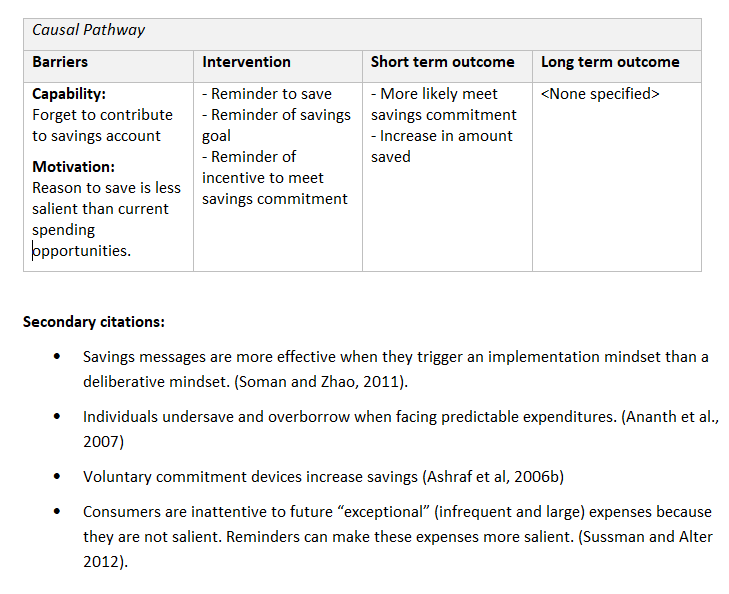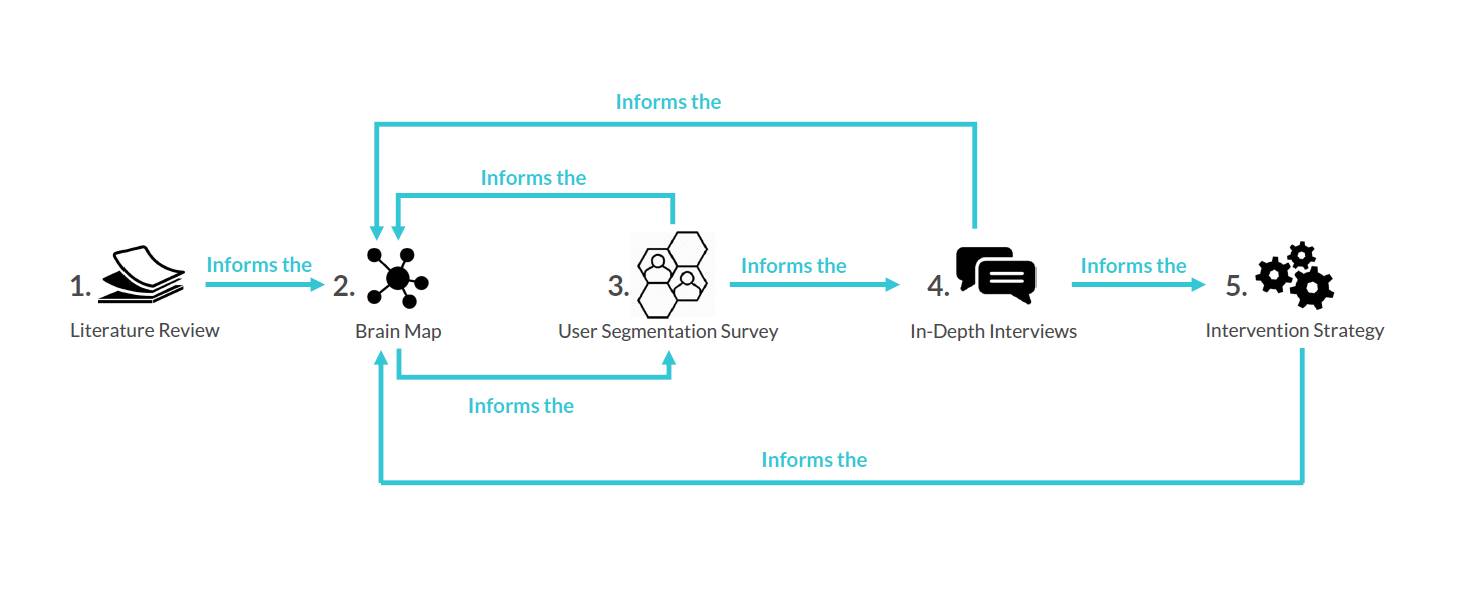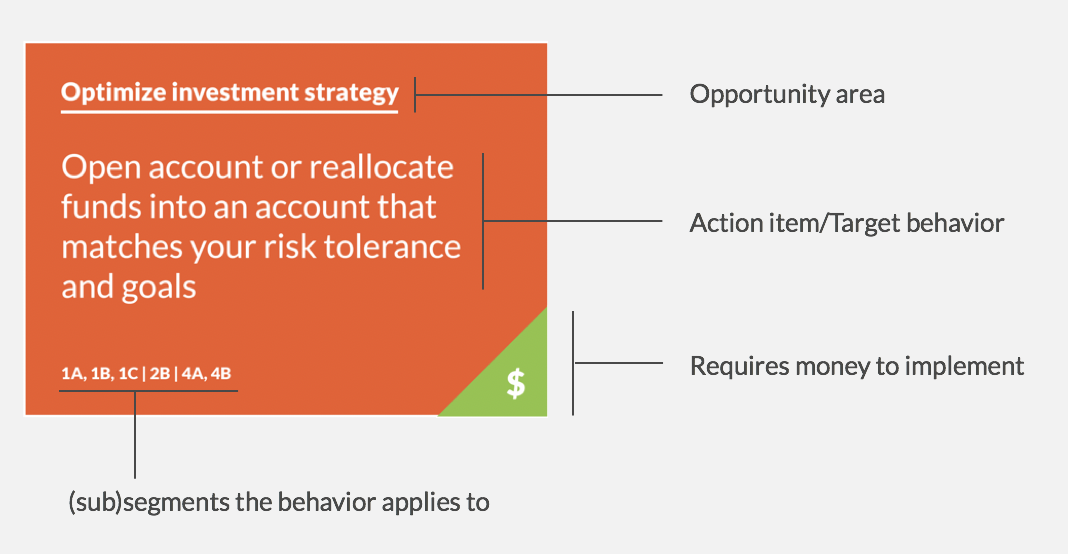Behaviorally-informed strategies to improve financial wellness
Client: National Bank | Role: Intervention research and design, Mad*Pow | Year: 2019
Abstract
Our client wanted to create a financial wellness benefit for employees that promoted not only financial security in retirement, but financial security in the present.
This seven-month project involved a literature review on the determinants of financial wellness and prior effective interventions, a nationally representative survey, and 72 audience interviews to understand financial wellness and how we could help people improve it.
We synthesized these findings into a behaviorally-informed guide that outlines relevant user segments, their needs, and strategies the bank could implement to support employees’ financial wellness.

Challenge
Most employee benefits, like retirement accounts and health insurance, serve employees who are already financially well. Despite the importance of behaviors like paying off high-interest debt, building emergency savings, and managing variable income, current employee resources do not help employees achieve these essential aspects of financial wellness.
Approach
Synthesize findings from literature review findings, audience interviews, and expert review to create an intervention strategy guide with prioritized recommendations to address the needs of each segment, as well as examples of how those strategies could be implemented in a benefit program.
Many of these strategies were aimed at organizational-level interventions, like providing no-or low interest loans to employees with low credit scores in an emergency or auto-enrolling employees in retirement contributions, since changing systems is often more effective than focusing on the behaviors of individuals.
Outcomes
We delivered a guide outlining potential interventions to support financial wellness for each user segment and designed concepts for two strategies to visualize how recommendations could be enacted in an employee benefit program.
Our client is currently working to implement our recommendations within the bank’s retirement offerings and identify additional departments to collaborate with in future phases of the project.
Project excerpts
First, understand the current state of financial wellness in America.
The project lead and I reviewed industry resources on best practices in promoting financial wellness, government publications on the state of financial wellness in America, best practices for financial planners, and academic literature on financial wellness and related concepts, such as financial literacy and financial capability.
Behaviors like setting aside at least $400 in emergency savings, paying off or avoiding high-interest debt, and minimizing income and expense volatility are essential foundations for individual financial wellness. Helping individuals overcome their barriers to achieving these goals became our guiding principle for creating the financial wellness benefit strategies.
Deliverables
- Literature review

Notes excerpt from financial wellness literature review
Then, identify what audience segments we can serve in the benefit program and their specific needs, priorities, and barriers.
From just under 2,000 responses in a nationally representative sample of employed Americans, the Mad*Pow team worked with a data scientist to develop an initial user segmentation based on financial wellness determinants from the literature review.
We supplemented survey responses with 72 in-depth interviews with members of each segment to learn more about needs, attitudes, and concepts that we couldn’t cover in the survey. I helped moderate anad analyze these interviews. From this research, we were able to identify four segments to guide concept development.
Deliverables
- Segmentation survey
- User interview findings
- Audience segments

Diagram showing relationship between research activities
Then, develop strategies to support people in each segment to improve their financial wellness.
I co-developed and led a collaborative session with our clients to assess the most effective order of operations for building financial wellness for each segment.
The project lead and I synthesized this recommended order of operations, findings from the audience survey and interviews, and the literature review to create an intervention strategy guide with prioritized recommendations to address the needs of each segment, as well as examples of how those strategies could be implemented in a benefit program.
Deliverables
- Workshop to prioritize opportunities
- Financial wellness intervention strategy guide

Sample target behavior card for prioritization session
Finally, design concepts to visualize how these strategies could be enacted in an employee benefit program.
After sharing the intervention guide, we worked with our clients to select two strategies to build out in more detail to demonstrate how the bank could integrate these strategies within their digital benefits offerings.
I worked with the team’s interaction designer to develop high-fidelity prototypes and pitch materials for each concept tool, which addressed saving for retirement and paying off debt.
Deliverables
- Concept design for two digital financial wellness benefits

Diagram illustrating individual and organizational-level interventions

Early concept sketches for a tool to help employees manage and prioritize debt payments
Team contribution
I was responsible for half of the literature review and report. I served as both a moderator and note-taker for interviews and helped synthesize insights to communicate to the client team in reports and presentations. I led creation of the final intervention strategy guide and translated these strategies into design concepts and screens.
